STS-85
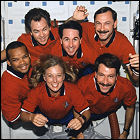 NASA launches Space Shuttle Discovery on the 86th shuttle flight, a 12-day mission to deploy a spectroscopy experiment and practice spacewalking construction techniques vital to the upcoming early missions to build the International Space Station. Aboard Discovery for her 23rd flight are Commander Curtis Brown, Pilot Kent Rominger, mission specialists Jan Davis, Robert Curbeam and Stephen Robinson, and payload specialist Bjarni Tryggvason.
NASA launches Space Shuttle Discovery on the 86th shuttle flight, a 12-day mission to deploy a spectroscopy experiment and practice spacewalking construction techniques vital to the upcoming early missions to build the International Space Station. Aboard Discovery for her 23rd flight are Commander Curtis Brown, Pilot Kent Rominger, mission specialists Jan Davis, Robert Curbeam and Stephen Robinson, and payload specialist Bjarni Tryggvason.
STS-94: do-over in space
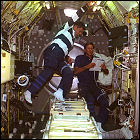 For the first and only time in the history of the American space program, a previously aborted mission is flown with the same vehicle, cargo and crew. Space Shuttle Columbia returns to orbit with Spacelab in its cargo bay for an attempt to fully carry out the aborted STS-83 mission, which was recalled to Earth in April. This time, the mission is successful, with nearly 16 days of microgravity experiments carried out by the crew. Flying Columbia – again – are Commander James Halsell, Pilot Susan Still, Payload Commander Janice Voss, mission specialists Donald Thomas and Michael Gernhardt, and payload specialists Roger Crouch and Greg Linteris.
For the first and only time in the history of the American space program, a previously aborted mission is flown with the same vehicle, cargo and crew. Space Shuttle Columbia returns to orbit with Spacelab in its cargo bay for an attempt to fully carry out the aborted STS-83 mission, which was recalled to Earth in April. This time, the mission is successful, with nearly 16 days of microgravity experiments carried out by the crew. Flying Columbia – again – are Commander James Halsell, Pilot Susan Still, Payload Commander Janice Voss, mission specialists Donald Thomas and Michael Gernhardt, and payload specialists Roger Crouch and Greg Linteris.
STS-84: sixth Shuttle-Mir docking
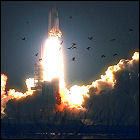 Space Shuttle Atlantis lifts off on the 84th shuttle mission, a ten-day flight with a visit to the Mir space station. Among the supplies hauled to Mir by Atlantis is a new oxygen generator to replace one damaged by a fire aboard the station in February. The crew for Atlantis’ 18th flight is Commander Charles Precourt, Pilot Eileen Collins, mission specialists Michael Foale, Carlos Noriega, Edward Lu, Jean-Francois Clervoy and cosmonaut Elena Kondakova. Foale remains to take up residence on Mir, while American astronaut Jerry Linenger leaves the station to return with the shuttle crew, having spent 132 days in space.
Space Shuttle Atlantis lifts off on the 84th shuttle mission, a ten-day flight with a visit to the Mir space station. Among the supplies hauled to Mir by Atlantis is a new oxygen generator to replace one damaged by a fire aboard the station in February. The crew for Atlantis’ 18th flight is Commander Charles Precourt, Pilot Eileen Collins, mission specialists Michael Foale, Carlos Noriega, Edward Lu, Jean-Francois Clervoy and cosmonaut Elena Kondakova. Foale remains to take up residence on Mir, while American astronaut Jerry Linenger leaves the station to return with the shuttle crew, having spent 132 days in space.
STS-83: recalled to Earth
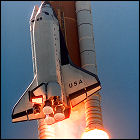 Space Shuttle Columbia is launched on the 83rd shuttle mission, intended to last over two weeks. In the cargo bay, the Spacelab module is set up for an intensive study of the behavior of natural processes in microgravity. A recurring issue with one of the shuttle’s three fuel cells concerns ground controllers enough to recall Columbia to Earth after only 63 orbits, only the third time a shuttle mission has been cut short. Aboard Columbia for her 22nd flight are Commander James Halsell, Pilot Susan Still, Payload Commander Janice Voss, mission specialists Donald Thomas and Michael Gernhardt, and payload specialists Roger Crouch and Greg Linteris. A reflight of the Spacelab mission is scheduled for the upcoming STS-94 mission in July.
Space Shuttle Columbia is launched on the 83rd shuttle mission, intended to last over two weeks. In the cargo bay, the Spacelab module is set up for an intensive study of the behavior of natural processes in microgravity. A recurring issue with one of the shuttle’s three fuel cells concerns ground controllers enough to recall Columbia to Earth after only 63 orbits, only the third time a shuttle mission has been cut short. Aboard Columbia for her 22nd flight are Commander James Halsell, Pilot Susan Still, Payload Commander Janice Voss, mission specialists Donald Thomas and Michael Gernhardt, and payload specialists Roger Crouch and Greg Linteris. A reflight of the Spacelab mission is scheduled for the upcoming STS-94 mission in July.
STS-82: back to Hubble
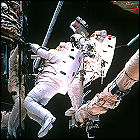 Space Shuttle Discovery lifts off on a ten-day mission to service the Hubble Space Telescope. Over 30 hours of spacewalks are conducted to repair and upgrade Hubble with new parts, and the shuttle engines are fired in short, steady bursts to raise the telescope’s orbit by over eight miles before it is released again. Aboard Discovery on her 22nd flight are Commander Kenneth Bowersox, Pilot Scott Horowitz, and mission specialists Mark Lee, Steven Hawley, Gregory Harbaugh, Steven Smith and Joseph Tanner.
Space Shuttle Discovery lifts off on a ten-day mission to service the Hubble Space Telescope. Over 30 hours of spacewalks are conducted to repair and upgrade Hubble with new parts, and the shuttle engines are fired in short, steady bursts to raise the telescope’s orbit by over eight miles before it is released again. Aboard Discovery on her 22nd flight are Commander Kenneth Bowersox, Pilot Scott Horowitz, and mission specialists Mark Lee, Steven Hawley, Gregory Harbaugh, Steven Smith and Joseph Tanner.
STS-81
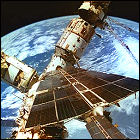 Space Shuttle Atlantis lifts off on the 81st shuttle flight, a ten-day mission featuring the fifth docking between Atlantis and the Mir space station. Atlantis again carries the SPACEHAB module in its cargo bay, and thousands of pounds of consumables and equipment are transferred from the shuttle to Mir. Aboard Atlantis for her 17th flight are Commander Michael Baker, Pilot Brent Jett, and mission specialists John Grunsfeld, Marsha Ivins, Peter Wisoff and Jerry Linenger. Linenger remains on Mir, while American Mir Expedition 22 crewmember John Blaha returns after 128 days in space.
Space Shuttle Atlantis lifts off on the 81st shuttle flight, a ten-day mission featuring the fifth docking between Atlantis and the Mir space station. Atlantis again carries the SPACEHAB module in its cargo bay, and thousands of pounds of consumables and equipment are transferred from the shuttle to Mir. Aboard Atlantis for her 17th flight are Commander Michael Baker, Pilot Brent Jett, and mission specialists John Grunsfeld, Marsha Ivins, Peter Wisoff and Jerry Linenger. Linenger remains on Mir, while American Mir Expedition 22 crewmember John Blaha returns after 128 days in space.
STS-80
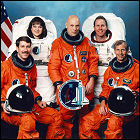 Space Shuttle Columbia lifts off on the 80th shuttle flight, a science mission lasting nearly 18 days. Two free-floating experiment platforms are deployed and then retrieved by the end of the mission for delivery back to Earth. Two spacewalks to test space station construction techniques are called off for safety reasons when a problem arises with Columbia’s airlock. Aboard Columbia for her 21st flight are Commander Kenneth Cockrell, Pilot Kent Rominger, and mission specialists Tammy Jernigan, Thomas Jones and Story Musgrave.
Space Shuttle Columbia lifts off on the 80th shuttle flight, a science mission lasting nearly 18 days. Two free-floating experiment platforms are deployed and then retrieved by the end of the mission for delivery back to Earth. Two spacewalks to test space station construction techniques are called off for safety reasons when a problem arises with Columbia’s airlock. Aboard Columbia for her 21st flight are Commander Kenneth Cockrell, Pilot Kent Rominger, and mission specialists Tammy Jernigan, Thomas Jones and Story Musgrave.
STS-79: fourth Shuttle-Mir mission
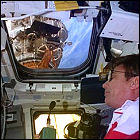 After multiple delays, including the entire launch stack having to be rolled back into the safety of the Vehicle Assembly Building to protect it from two back-to-back hurricanes, Space Shuttle Atlantis lifts off on the fourth mission to dock with the Russian Mir space station. Supplies are transferred to Mir, and numerous completed science experiments from Mir are loaded into the shuttle. Atlantis is flown by Commander William Readdy, Pilot Terrence Wilcutt, and mission specialists Thomas Akers, John Blaha, Jay Apt and Carl Walz. Blaha remains on Mir, taking the place of American astronaut Shannon Lucid, who has just set a new American space endurance record of 188 days in orbit; Lucid returns to Earth with the Atlantis crew.
After multiple delays, including the entire launch stack having to be rolled back into the safety of the Vehicle Assembly Building to protect it from two back-to-back hurricanes, Space Shuttle Atlantis lifts off on the fourth mission to dock with the Russian Mir space station. Supplies are transferred to Mir, and numerous completed science experiments from Mir are loaded into the shuttle. Atlantis is flown by Commander William Readdy, Pilot Terrence Wilcutt, and mission specialists Thomas Akers, John Blaha, Jay Apt and Carl Walz. Blaha remains on Mir, taking the place of American astronaut Shannon Lucid, who has just set a new American space endurance record of 188 days in orbit; Lucid returns to Earth with the Atlantis crew.
STS-78
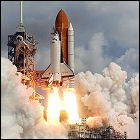 Space Shuttle Columbia lifts off on the 78th shuttle mission, a Spacelab flight lasting nearly 17 days and devoted to the effects of microgravity on various forms of life. The crew also tests maneuvers under consideration for a future Hubble Space Telescope servicing mission which could safely boost Hubble’s orbit without damaging it. Aboard Columbia for her 20th flight are Commander Terence Henricks, Pilot Kevin Kregel, flight engineer Susan Helms, mission specialists Richard Linnehan and Charles Brady, and payload specialists Jean-Jacques Favier and Robert Thirsk.
Space Shuttle Columbia lifts off on the 78th shuttle mission, a Spacelab flight lasting nearly 17 days and devoted to the effects of microgravity on various forms of life. The crew also tests maneuvers under consideration for a future Hubble Space Telescope servicing mission which could safely boost Hubble’s orbit without damaging it. Aboard Columbia for her 20th flight are Commander Terence Henricks, Pilot Kevin Kregel, flight engineer Susan Helms, mission specialists Richard Linnehan and Charles Brady, and payload specialists Jean-Jacques Favier and Robert Thirsk.
STS-77
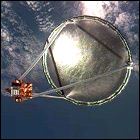 Space Shuttle Endeavour lifts off on the 77th shuttle mission, a ten-day flight to perform experiments in the cargo-bay-mounted SPACEHAB module, and a test of a free-flying inflatible antenna system. The crew also communicates with astronaut Shannon Lucid aboard Mir, though Endeavour and Mir are in different orbits. Aboard Endeavour for her 11th flight are Commander John Casper, Pilot Curtis Brown, and mission specialists Daniel Bursch, Mario Runco, Marc Garneau and Andrew Thomas.
Space Shuttle Endeavour lifts off on the 77th shuttle mission, a ten-day flight to perform experiments in the cargo-bay-mounted SPACEHAB module, and a test of a free-flying inflatible antenna system. The crew also communicates with astronaut Shannon Lucid aboard Mir, though Endeavour and Mir are in different orbits. Aboard Endeavour for her 11th flight are Commander John Casper, Pilot Curtis Brown, and mission specialists Daniel Bursch, Mario Runco, Marc Garneau and Andrew Thomas.
STS-76: third Shuttle-Mir docking
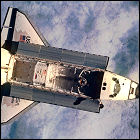 Space Shuttle Atlantis lifts off on the 76th shuttle mission, a flight to dock with the Russian space station Mir. Supplies are delivered to Mir by the Atlantis crew, and astronaut Shannon Lucid remains aboard Mir to join its Expedition 21 crew. Atlantis also carries the SPACEHAB module, where both the shuttle and station crews conduct joint scientific experiments. Aboard Atlantis for her 16th flight are Commander Kevin Chilton, Pilot Richard Searfoss, and mission specialists Shannon Lucid, Linda Godwin, Michael Clifford and Ronald Sega.
Space Shuttle Atlantis lifts off on the 76th shuttle mission, a flight to dock with the Russian space station Mir. Supplies are delivered to Mir by the Atlantis crew, and astronaut Shannon Lucid remains aboard Mir to join its Expedition 21 crew. Atlantis also carries the SPACEHAB module, where both the shuttle and station crews conduct joint scientific experiments. Aboard Atlantis for her 16th flight are Commander Kevin Chilton, Pilot Richard Searfoss, and mission specialists Shannon Lucid, Linda Godwin, Michael Clifford and Ronald Sega.
STS-75
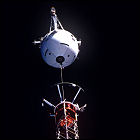 Space Shuttle Columbia is launched on the 75th shuttle flight, staying in orbit for nearly 16 days. The crew attempts to deploy a tethered satellite experiment flown unsuccessfully in 1992, only to watch as the tether snaps with the satellite 12 miles away from the shuttle. The remainder of the flight is spent conducting planned material science experiments. Aboard Columbia for her 19th flight are Commander Andrew Allen, Pilot Scott Horowitz, Payload Commander Franklin Chang-Diaz, and mission specialists Maurizio Cheli, Jeffrey Hoffman, Claude Nicollier and Umberto Guidoni. To this day, video of the satellite floating in space after the tether failure is circulated as “proof” of the existence of UFOs.
Space Shuttle Columbia is launched on the 75th shuttle flight, staying in orbit for nearly 16 days. The crew attempts to deploy a tethered satellite experiment flown unsuccessfully in 1992, only to watch as the tether snaps with the satellite 12 miles away from the shuttle. The remainder of the flight is spent conducting planned material science experiments. Aboard Columbia for her 19th flight are Commander Andrew Allen, Pilot Scott Horowitz, Payload Commander Franklin Chang-Diaz, and mission specialists Maurizio Cheli, Jeffrey Hoffman, Claude Nicollier and Umberto Guidoni. To this day, video of the satellite floating in space after the tether failure is circulated as “proof” of the existence of UFOs.
STS-72
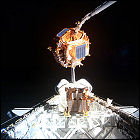 Space Shuttle Endeavour lifts off on the 74th flight of the shuttle program. Over nine days, Endeavour’s crew retrieves a Japanese satellite for return to Earth while deploying a NASA experiment which flies as far as 45 miles away from the shuttle for two days before it, too, is retrieved. More spacewalk techniques and technologies are tried out for future space station construction. Aboard Endeavour for her tenth flight are Commander Brian Duffy, Pilot Brent Jett, and mission specialists Leroy Chiao, Daniel Barry, Winston Scott and Koichi Wakata.
Space Shuttle Endeavour lifts off on the 74th flight of the shuttle program. Over nine days, Endeavour’s crew retrieves a Japanese satellite for return to Earth while deploying a NASA experiment which flies as far as 45 miles away from the shuttle for two days before it, too, is retrieved. More spacewalk techniques and technologies are tried out for future space station construction. Aboard Endeavour for her tenth flight are Commander Brian Duffy, Pilot Brent Jett, and mission specialists Leroy Chiao, Daniel Barry, Winston Scott and Koichi Wakata.
STS-74: Atlantis returns to Mir
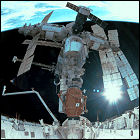 NASA launches Space Shuttle Atlantis on the 73rd shuttle flight, an eight-day mission to dock with Russian space station Mir. Due to the docking difficulties of the first flight – which required Mir crew members to move one of their station’s modules out of the shuttle’s way temporarily – Atlantis carries a Russian-made docking adapter which adds a tunnel to one of Mir’s docking ports, allowing the shuttle to join up with the station without further module relocation. Atlantis carries Commander Kenneth Cameron, Pilot James Halsell, and mission specialists Jerry Ross, William McArthur and Chris Hadfield to visit Mir; there is no crew exchange on this flight.
NASA launches Space Shuttle Atlantis on the 73rd shuttle flight, an eight-day mission to dock with Russian space station Mir. Due to the docking difficulties of the first flight – which required Mir crew members to move one of their station’s modules out of the shuttle’s way temporarily – Atlantis carries a Russian-made docking adapter which adds a tunnel to one of Mir’s docking ports, allowing the shuttle to join up with the station without further module relocation. Atlantis carries Commander Kenneth Cameron, Pilot James Halsell, and mission specialists Jerry Ross, William McArthur and Chris Hadfield to visit Mir; there is no crew exchange on this flight.
STS-73
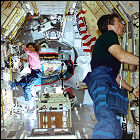 Space Shuttle Columbia is launched on the 72nd shuttle mission, and Columbia’s 18th visit to Earth orbit. Over a 16-day period, the Spacelab module mounted in the cargo bay hosts the second U.S. Microgravity Laboratory mission, with experiments conducted around the clock. The first pitch of the fifth game of the 1995 World Series is thrown aboard Columbia and broadcast live – the first time that the first pitch of a game took place somewhere other than the ballpark in question. Columbia is manned by Commander Kenneth Bowersox, Pilot Kent Rominger, Payload Commander Kathryn Thornton, mission specialists Catherine Coleman and Michael Lopez-Alegria, and payload specialists Fred Leslie and Albert Sacco.
Space Shuttle Columbia is launched on the 72nd shuttle mission, and Columbia’s 18th visit to Earth orbit. Over a 16-day period, the Spacelab module mounted in the cargo bay hosts the second U.S. Microgravity Laboratory mission, with experiments conducted around the clock. The first pitch of the fifth game of the 1995 World Series is thrown aboard Columbia and broadcast live – the first time that the first pitch of a game took place somewhere other than the ballpark in question. Columbia is manned by Commander Kenneth Bowersox, Pilot Kent Rominger, Payload Commander Kathryn Thornton, mission specialists Catherine Coleman and Michael Lopez-Alegria, and payload specialists Fred Leslie and Albert Sacco.
STS-69
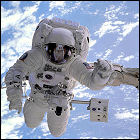 Space Shuttle Endeavour lifts off on the 71st shuttle flight, an 11-day mission to conduct solar wind experiments and test out new spacewalking techniques and space suit revisions for future construction of the International Space Station. Aboard Endeavour for her ninth flight are Commander David Walker, Pilot Kenneth Cockrell, Payload Commander James Voss, and mission specialists James Newman and Michael Gernhardt.
Space Shuttle Endeavour lifts off on the 71st shuttle flight, an 11-day mission to conduct solar wind experiments and test out new spacewalking techniques and space suit revisions for future construction of the International Space Station. Aboard Endeavour for her ninth flight are Commander David Walker, Pilot Kenneth Cockrell, Payload Commander James Voss, and mission specialists James Newman and Michael Gernhardt.
STS-70
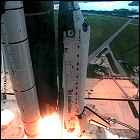 Space Shuttle Discovery lifts off on the 70th shuttle flight, a nine-day mission to deploy a TDRS (Tracking & Data Relay Satellite) for NASA. The flight has seen many delays, including repairs made necessary by woodpeckers poking holes in the shuttle’s external fuel tank! The crew – consisting of Commander Terence Henricks, Pilot Kevin Kregel, and mission specialists Nancy Jane Currie, Donald Thomas and Mary Ellen Weber – conducts material and medical experiments after the deployment of the final satellite in the TDRS constellation.
Space Shuttle Discovery lifts off on the 70th shuttle flight, a nine-day mission to deploy a TDRS (Tracking & Data Relay Satellite) for NASA. The flight has seen many delays, including repairs made necessary by woodpeckers poking holes in the shuttle’s external fuel tank! The crew – consisting of Commander Terence Henricks, Pilot Kevin Kregel, and mission specialists Nancy Jane Currie, Donald Thomas and Mary Ellen Weber – conducts material and medical experiments after the deployment of the final satellite in the TDRS constellation.
STS-71: the shuttle docks at Mir
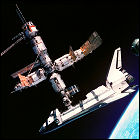 Space Shuttle Atlantis lifts off on an almost-ten-day mission to dock with the Russian space station Mir. The first docking proves to be a chore, as the Mir crew has to move one of the station’s modules to a different docking port to accomodate the shuttle. The historic docking – the first joint operation between the two countries since the Apollo-Soyuz mission almost exactly 20 years earlier – results in the largest man-made object in space to date. Aboard Atlantis are Commander Robert Gibson, Pilot Charles Precourt, and mission specialists Ellen Baker, Bonnie Dunbar and Gregory Harbaugh; cosmonauts Anatoly Solovyev and Nikolai Budarin are transported to Mir aboard Atlantis to become part of Mir Expedition 19, while Expedition 18 crew members Norman Thagard, Vladimir Dezhurov and Gannady Strekalov return to Earth after more than three months aboard Mir.
Space Shuttle Atlantis lifts off on an almost-ten-day mission to dock with the Russian space station Mir. The first docking proves to be a chore, as the Mir crew has to move one of the station’s modules to a different docking port to accomodate the shuttle. The historic docking – the first joint operation between the two countries since the Apollo-Soyuz mission almost exactly 20 years earlier – results in the largest man-made object in space to date. Aboard Atlantis are Commander Robert Gibson, Pilot Charles Precourt, and mission specialists Ellen Baker, Bonnie Dunbar and Gregory Harbaugh; cosmonauts Anatoly Solovyev and Nikolai Budarin are transported to Mir aboard Atlantis to become part of Mir Expedition 19, while Expedition 18 crew members Norman Thagard, Vladimir Dezhurov and Gannady Strekalov return to Earth after more than three months aboard Mir.
Soyuz TM-21
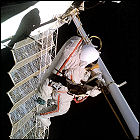 An American astronaut lifts off aboard a Russian Soyuz spacecraft for the first time ever with the launch of Soyuz TM-21, a mission to the Mir space station. Cosmonauts Vladimir Dezhurov and Gennady Strekalov are joined by astronaut Norman Thagard aboard Mir, where they remain for 115 days. During that time, they witness the arrival of the Spektr module, a new addition to the station, and they ultimately return to Earth aboard space shuttle Atlantis in July 1995; Soyuz TM-21 remains at the station, where a future Mir crew uses it to return to Earth. During the Atlantis mission, a new record is set for the number of humans in space, as the station and shuttle crews add up to 13 people in orbit at once.
An American astronaut lifts off aboard a Russian Soyuz spacecraft for the first time ever with the launch of Soyuz TM-21, a mission to the Mir space station. Cosmonauts Vladimir Dezhurov and Gennady Strekalov are joined by astronaut Norman Thagard aboard Mir, where they remain for 115 days. During that time, they witness the arrival of the Spektr module, a new addition to the station, and they ultimately return to Earth aboard space shuttle Atlantis in July 1995; Soyuz TM-21 remains at the station, where a future Mir crew uses it to return to Earth. During the Atlantis mission, a new record is set for the number of humans in space, as the station and shuttle crews add up to 13 people in orbit at once.
STS-67
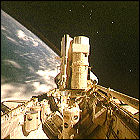 NASA launches Space Shuttle Endeavour on the longest flight of the shuttle program to date – over 16 and a half days – with the ASTRO astronomy experiment package mounted in the cargo bay. Some astronomical observations on this mission are conducted in tandem with the Hubble Space Telescope. Aboard Endeavour for her eighth flight are Commander Stephen Oswald, Pilot William Gregory, Payload Commander Tammy Jernigan, mission specialists John Grunsfeld and Wendy Lawrence, and payload specialists Ronald Parise and Samuel Durrance.
NASA launches Space Shuttle Endeavour on the longest flight of the shuttle program to date – over 16 and a half days – with the ASTRO astronomy experiment package mounted in the cargo bay. Some astronomical observations on this mission are conducted in tandem with the Hubble Space Telescope. Aboard Endeavour for her eighth flight are Commander Stephen Oswald, Pilot William Gregory, Payload Commander Tammy Jernigan, mission specialists John Grunsfeld and Wendy Lawrence, and payload specialists Ronald Parise and Samuel Durrance.
STS-63: the shuttle visits Mir
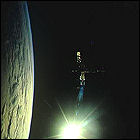 Space Shuttle Discovery lifts off on the 67th flight of the shuttle program, a history-making mission that sees Discovery conducting rendezvous maneuvers at the Russian space station Mir. Though the shuttle isn’t equipped to dock at Mir, the close flyby is a necessary step before a docking mission can take place, and Discovery’s crew includes a former Mir cosmonaut. The crew for this flight is Commander James Wetherbee, Pilot Eileen M. Collins, and mission Specialists Michael Foale, Janice Voss, Bernard Harris and Vladimar Titov.
Space Shuttle Discovery lifts off on the 67th flight of the shuttle program, a history-making mission that sees Discovery conducting rendezvous maneuvers at the Russian space station Mir. Though the shuttle isn’t equipped to dock at Mir, the close flyby is a necessary step before a docking mission can take place, and Discovery’s crew includes a former Mir cosmonaut. The crew for this flight is Commander James Wetherbee, Pilot Eileen M. Collins, and mission Specialists Michael Foale, Janice Voss, Bernard Harris and Vladimar Titov.
STS-66
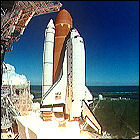 Space Shuttle Atlantis lifts off on its first flight in two years, an 11-day mission to conduct studies of Earth’s atmosphere with the ATLAS package mounted in the cargo bay. Aboard Atlantis for her 13th flight are Commander Donald McMonagle, Pilot Curtis Brown, Payload Commander Ellen Ochoa, and mission specialists Scott Parazynski, Joseph Tanner and Jean-Francois Clervoy.
Space Shuttle Atlantis lifts off on its first flight in two years, an 11-day mission to conduct studies of Earth’s atmosphere with the ATLAS package mounted in the cargo bay. Aboard Atlantis for her 13th flight are Commander Donald McMonagle, Pilot Curtis Brown, Payload Commander Ellen Ochoa, and mission specialists Scott Parazynski, Joseph Tanner and Jean-Francois Clervoy.
STS-68
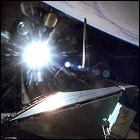 Space Shuttle Endeavour lifts off on the shuttle program’s 65th mission. The eleven-day flight is a second round of space radar experiments, using a cargo-bay-mounted radar system that flew earlier in 1994 aboard Endeavour. The crew for this flight consists of Commander Michael Baker, Pilot Terrence Wilcutt, Payload Commander Thomas Jones, and mission specialists Steven Smith, Daniel Bursch and Peter Wisoff.
Space Shuttle Endeavour lifts off on the shuttle program’s 65th mission. The eleven-day flight is a second round of space radar experiments, using a cargo-bay-mounted radar system that flew earlier in 1994 aboard Endeavour. The crew for this flight consists of Commander Michael Baker, Pilot Terrence Wilcutt, Payload Commander Thomas Jones, and mission specialists Steven Smith, Daniel Bursch and Peter Wisoff.
STS-64
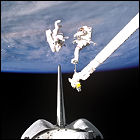 NASA launches Space Shuttle Discovery on the 64th flight of the shuttle program. The cargo bay carries an experiment to test LIDAR applications from orbit, and is the site of a six-hour spacewalk to test an alternative to the retired MMU “jet pack” for EVA rescue purposes. Aboard Discovery for her 19th mission are Commander Richard Richards, Pilot Blaine Hammond, and mission specialists Jerry Linenger, Susan Helms, Carl Meade and Mark Lee.
NASA launches Space Shuttle Discovery on the 64th flight of the shuttle program. The cargo bay carries an experiment to test LIDAR applications from orbit, and is the site of a six-hour spacewalk to test an alternative to the retired MMU “jet pack” for EVA rescue purposes. Aboard Discovery for her 19th mission are Commander Richard Richards, Pilot Blaine Hammond, and mission specialists Jerry Linenger, Susan Helms, Carl Meade and Mark Lee.
STS-65
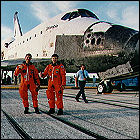 Space Shuttle Columbia is launched on the 63rd mission of the shuttle program. For two weeks, Columbia’s crew participates in the second IML (International Microgravity Laboratory) flight, conducting experiments relying on zero G around the clock. Columbia is also in orbit during the 25th anniversary of Apollo 11, the moon landing mission whose command/service module was also named Columbia. Aboard for Columbia’s 17th flight are Commander Robert Cabana, Pilot James Halsell, Payload Commander Richard Hieb, mission specialists Carl Walz, Leroy Chiao and Donald Thomas, and payload specialist Chiaki Naito-Mukai, the first Japanese woman in space.
Space Shuttle Columbia is launched on the 63rd mission of the shuttle program. For two weeks, Columbia’s crew participates in the second IML (International Microgravity Laboratory) flight, conducting experiments relying on zero G around the clock. Columbia is also in orbit during the 25th anniversary of Apollo 11, the moon landing mission whose command/service module was also named Columbia. Aboard for Columbia’s 17th flight are Commander Robert Cabana, Pilot James Halsell, Payload Commander Richard Hieb, mission specialists Carl Walz, Leroy Chiao and Donald Thomas, and payload specialist Chiaki Naito-Mukai, the first Japanese woman in space.
STS-59
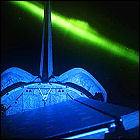 NASA launches Space Shuttle Endeavour on an 11-day mission to carry the Space Radar Laboratory experiment into orbit. The radar systems map sites on Earth and test other applications for orbital radar. Aboard Endeavour for her sixth flight are Commander Sidney Gutierrez, Pilot Kevin Chilton, Payload Commander Linda Godwin, and mission specialists Jay Apt, Michael Clifford and Thomas Jones.
NASA launches Space Shuttle Endeavour on an 11-day mission to carry the Space Radar Laboratory experiment into orbit. The radar systems map sites on Earth and test other applications for orbital radar. Aboard Endeavour for her sixth flight are Commander Sidney Gutierrez, Pilot Kevin Chilton, Payload Commander Linda Godwin, and mission specialists Jay Apt, Michael Clifford and Thomas Jones.
STS-62
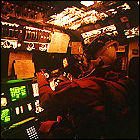 Space Shuttle Columbia lifts off on the 61st shuttle mission, a two-week visit to Earth orbit carrying two cargo-bay-mounted experiment systems operated primarily from the ground. Crew members participate in experiments involving the side-effects of long-term space travel. The crew for Columbia’s 16th flight consists of Commander John Casper, Pilot Andrew Allen, and mission specialists Pierre Thuot, Charles Gemar and Marsha Ivins.
Space Shuttle Columbia lifts off on the 61st shuttle mission, a two-week visit to Earth orbit carrying two cargo-bay-mounted experiment systems operated primarily from the ground. Crew members participate in experiments involving the side-effects of long-term space travel. The crew for Columbia’s 16th flight consists of Commander John Casper, Pilot Andrew Allen, and mission specialists Pierre Thuot, Charles Gemar and Marsha Ivins.
STS-60
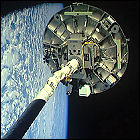 Space Shuttle Discovery lifts off on the 60th flight of the shuttle program. During its eight days in orbit, Discovery hosts the first Russian cosmonaut ever to fly aboard an American spacecraft, initiating an ongoing agreement between the two countries’ space agencies that will eventually lead to shuttles visiting Mir and the construction of the International Space Station. Aboard Discovery for her 18th flight are Commander Charles Bolden, Pilot Kenneth Reightler, and mission specialists Jan Davis, Ronald Sega, Franklin Chang-Diaz and Sergei Krikalev.
Space Shuttle Discovery lifts off on the 60th flight of the shuttle program. During its eight days in orbit, Discovery hosts the first Russian cosmonaut ever to fly aboard an American spacecraft, initiating an ongoing agreement between the two countries’ space agencies that will eventually lead to shuttles visiting Mir and the construction of the International Space Station. Aboard Discovery for her 18th flight are Commander Charles Bolden, Pilot Kenneth Reightler, and mission specialists Jan Davis, Ronald Sega, Franklin Chang-Diaz and Sergei Krikalev.
STS-61: new eyes for Hubble
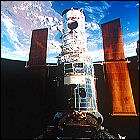 NASA launches Space Shuttle Endeavour on a ten-day mission to retrieve and repair the Hubble Space Telescope, which was launched in 1990 with flawed optics. With the $2,000,000,000 telescope held steady in the cargo bay, Endeavour astronauts conduct repairs during spacewalks totaling over 35 hours of the mission, before releasing Hubble back into orbit with new eyes. Aboard Endeavour for her history-making fifth flight are Commander Richard Covey, Pilot Kenneth Bowersox, Payload Commander Story Musgrave, and mission specialists Kathryn Thornton, Claude Nicollier, Jeffrey Hoffman and Tom Akers.
NASA launches Space Shuttle Endeavour on a ten-day mission to retrieve and repair the Hubble Space Telescope, which was launched in 1990 with flawed optics. With the $2,000,000,000 telescope held steady in the cargo bay, Endeavour astronauts conduct repairs during spacewalks totaling over 35 hours of the mission, before releasing Hubble back into orbit with new eyes. Aboard Endeavour for her history-making fifth flight are Commander Richard Covey, Pilot Kenneth Bowersox, Payload Commander Story Musgrave, and mission specialists Kathryn Thornton, Claude Nicollier, Jeffrey Hoffman and Tom Akers.
STS-58
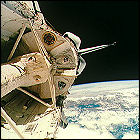 Space Shuttle Columbia is launched on the 58th shuttle mission, a two-week stay in orbit with the Spacelab module. This is the second Spacelab flight devoted to medical experiments and life sciences. Aboard Columbia for her 15th flight are Commander John Blaha, Pilot Richard Searfoss, mission specialists Rhea Seddon, William McArthur, David Wolf and Shannon Lucid, and payload specialist Martin Fettman.
Space Shuttle Columbia is launched on the 58th shuttle mission, a two-week stay in orbit with the Spacelab module. This is the second Spacelab flight devoted to medical experiments and life sciences. Aboard Columbia for her 15th flight are Commander John Blaha, Pilot Richard Searfoss, mission specialists Rhea Seddon, William McArthur, David Wolf and Shannon Lucid, and payload specialist Martin Fettman.